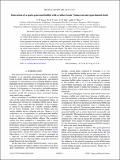Interaction of a spark-generated bubble with a rubber beam: Numerical and experimental study
Author(s)
Gong, S. W.; Goh, B. H. T.; Ohl, S. W.; Khoo, Boo Cheong
DownloadGong-2012-Interaction of a spark-generated bubble with a rubber beam.pdf (5.890Mb)
PUBLISHER_POLICY
Publisher Policy
Article is made available in accordance with the publisher's policy and may be subject to US copyright law. Please refer to the publisher's site for terms of use.
Terms of use
Metadata
Show full item recordAbstract
In this paper, the physical behaviors of the interaction between a spark-generated bubble and a rubber beam are studied. Both numerical and experimental approaches are employed to investigate the bubble collapse near the rubber beam (which acts as a flexible boundary) and the corresponding large deformation of the beam. Good agreement between the numerical simulations and experimental observations is achieved. The analysis reveals that the ratio of the bubble-beam distance to the maximum bubble radius influences the bubble evolution (from expansion to collapse) and the beam deformation. The stiffness of the beam plays an important role in the elastic beam response to bubble expansion and collapse. The effect of the vapor pressure on both bubble collapses and beam deflections is also examined. The results from this paper may provide physical insight into the complex physics of the bubble-rubber interaction. The understanding is possibly applicable in biomedicine for drug delivery to tissue, which is a soft material. It is also probably useful in the marine industry where ultrasonic bubbles are generated for the defouling of ship surfaces, which has been coated with an elastic material. There is also potential interest in underwater explosions near elastic structures.
Date issued
2012-08Department
Massachusetts Institute of Technology. Department of Aeronautics and AstronauticsJournal
Physical Review E
Publisher
American Physical Society
Citation
Gong, S. et al. “Interaction of a Spark-generated Bubble with a Rubber Beam: Numerical and Experimental Study.” Physical Review E 86.2 (2012). ©2012 American Physical Society
Version: Final published version
ISSN
1539-3755
1550-2376